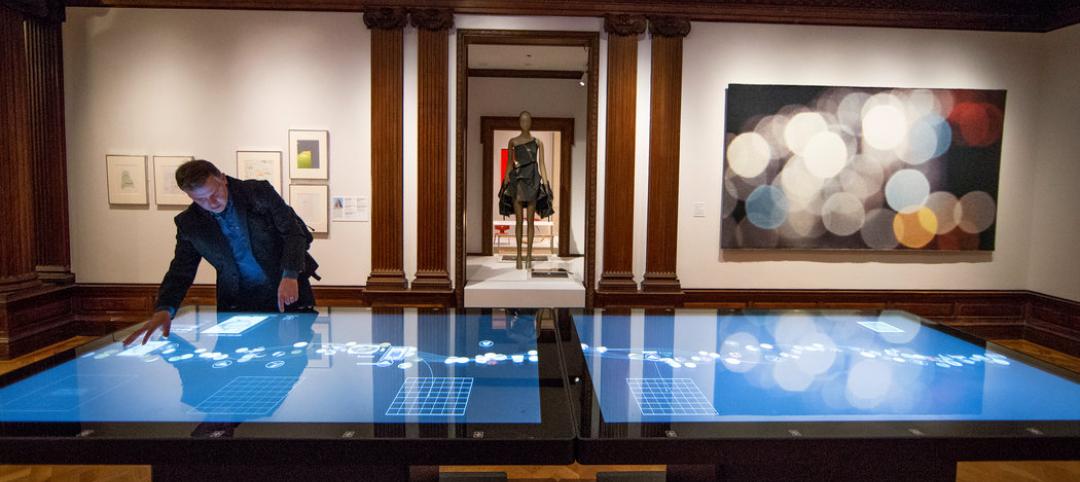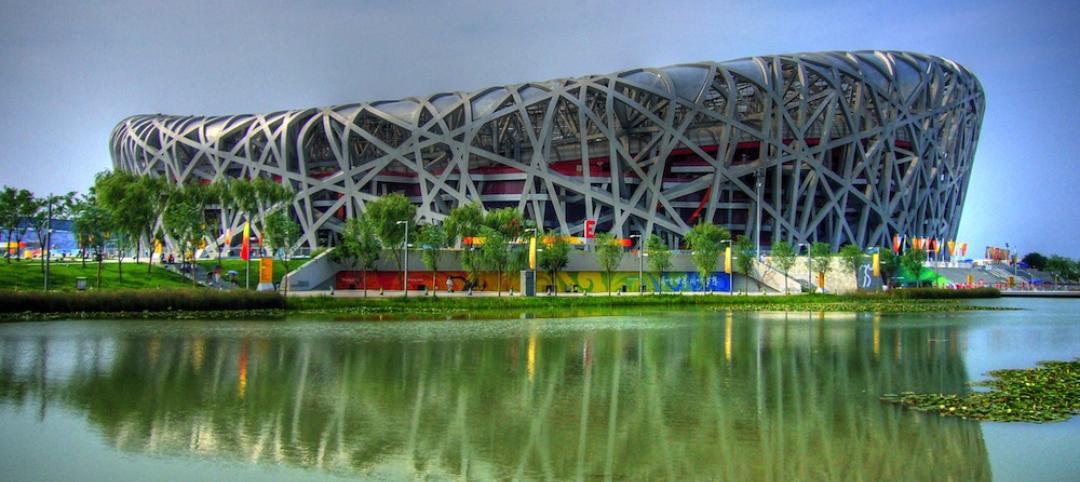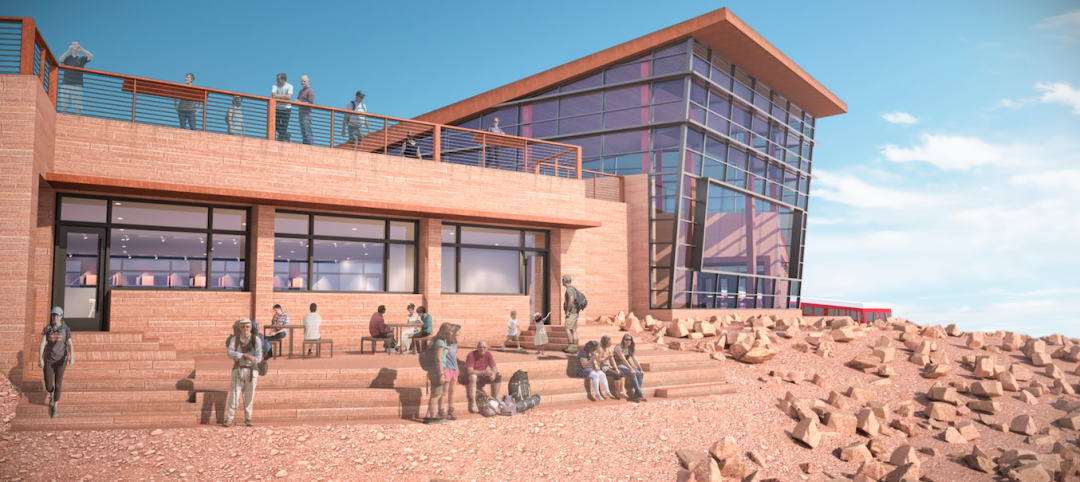 |
| EMPAC is built into a hillside overlooking the Hudson Valley on the RPI campus. Grimshaw’s design was chosen partially because of how it took advantage of the site. |
Rensselaer Polytechnic Institute, the nation's oldest technology university, has long prided itself on its state-of-the-art design and engineering curriculum. Several years ago, to call attention to its equally estimable media and performing arts programs, RPI commissioned British architect Sir Nicholas Grimshaw to design the Curtis R. Priem Experimental Media and Performing Arts Center (EMPAC).
As we recently noted (see “BIM + IPD: 3 Success Stories,” April;), Grimshaw's clever and dramatic “ship-in-a-bottle” structure has become the centerpiece of the Troy, N.Y. campus.
In judging the EMPAC project for the 2009 Building Team Awards, the judges were impressed with the way in which the Building Team addressed the site, a steep hillside overlooking the Hudson Valley. “One of the things that led to our decision to select Grimshaw was that they captured early on how to best take advantage of the site,” said Claude Rounds, the university's VP of administration. “They not only gave an architectural concept of how the structure would fit, but how it would actually complement and enhance the site.” From the early days of the project, RPI wanted a Building Team that would make the most effective use of the difficult site conditions.
 |
| The walls of EMPAC’s two studios are composed of adjustable acoustic diffusion panels painted matte black to allow an acoustic con• guration for any performance. Studio 1 (above) is capable of audio presentation but is optimized for dance, visualization, multi-screen, and immersive performances. PHOTO: TURNER CONSTRUCTION CO |
In 2004, RPI turned to the integrated project delivery team at the nation's largest construction firm, Turner Construction Co., to fulfill Grimshaw's vision. The project's original construction manager had parted ways with Rensselaer earlier that year due to constructability issues. Turner assembled a blue-ribbon team: Architectural Woodwork Industries, Philadelphia (custom woodwork), Supermetals Structures, Quebec (structural steel design), Radius Track of Minnesota (steel fabrication), Gartner (curtain wall), Davis Brody Bond (architect of record), Buro Happold (structural and mechanical engineering systems), GeoTech (site engineers), Fisher Dachs Associates (theater consultant), and Kirkegaard Associates (acoustician).
“We only asked for proposals from people who would come to it in a collaborative fashion,” said Stephen Coates, project manager for Turner. Language was written into the IPD contract documents to make it clear that all participants were responsible for participating in an iterative design process, according to Coates. RPI also demanded the highest standards of performance and acoustics in the statement of program and design intent.
An intense, four-month design process followed the selection of the Building Team members. At Grimshaw's suggestion everyone used Rhinoceros, a 3D design application that allowed the team to model and test the curved surfaces of EMPAC. The team was literally passing new models back and forth to each other on a daily basis. Grimshaw's computational design director, Shane Burger, said using Rhino as a common design tool helped achieve not only a common aesthetic goal, but also a common technical and construction goal.
 |
| Because of the difficult site, EMPAC was built into the hillside site in staggered steps. The performance spaces were acoustically isolated on one side of the building with lobbies and offices on the other side. PHOTO: TURNER CONSTRUCTION CO. |
The initial design went through three major conceptual changes during this process. In the end, the team found a way to deliver four primary performance spaces and all the office space that the university needed, each in an isolated portion of the building, while still staying honest to Grimshaw's aesthetic vision.
Instead of fighting against the site, the final design took advantage of it, maximizing views for patrons with glass curtain wall on all sides. By building the structure into the hill, the design used all the space available to create an unmistakable focus for the RPI campus.
The collaboration continued into the construction process. Gartner supervised installation of EMPAC's north curtain wall and created a rules system in the model for installation of the custom panels in the performance spaces; this consisted of a collection of custom panels of varying depth. For audience comfort, each seat in the theater has an air supply below it. Buro Happold created a computational fluid dynamics analysis for each seating design change.
 |
| Major structural elements of EMPAC include lagged shoring walls, caissons, mini-piles, pile caps and grade beams, a concrete superstructure (top), steel framing, and composite decks. Turner Construction Company delivered the complex design on time and on budget. |
Every interior space is connected through fiber-optic cables to a supercomputer on campus—at RPI, computing is intrinsically related to delivering the performing arts. “The space had to be tunable, just as you'd tune an instrument,” said Burger.
Theater consultant Fisher Dachs Associates and acoustician Kirkegaard Associates worked closely with the design team to deliver EMPAC's dramatic 1,200-seat theater space. The ceiling consists of panels of Nomex-brand heat- and fire-resistant fabric, each less than one millimeter thick, supported on a web of stainless-steel cables.
Nomex was selected for its ability to gently reflect high-frequency sound while remaining transparent to mid- and low-frequency sound. This combination of attributes provides acoustic support to the musicians on the platform while allowing the volume above the ceiling to contribute to the reverberance expected of a first-rate orchestral hall.
The fabric ceiling, like the walls, is gently convex in shape and masks the electrical and mechanical equipment and light fixtures situated above. An aural study of the acoustic design was done before construction to verify its feasibility. “It was the intense focus on creating a world-class venue for acoustics that we felt set [the project] apart,” said Grimshaw supervising partner Mark Husser.
In bestowing its only Platinum Award this year on EMPAC, BD+C's Building Team Awards jury praised both its design and construction excellence. “The acoustical features are incorporated into the design instead of being tacked on during construction,” said Tracy Nicholas, VP, Alter Construction Management, Skokie, Ill. “They used BIM and fully integrated project delivery to the fullest extent to deliver a great project.”
“The project had to do something beyond ordinary, and this does it,” said Carol Ross Barney, FAIA, of Chicago's Ross Barney + Jankowski, designer of the Oklahoma City Federal Building and many university projects. “It's an example of aesthetics and technology done together very well. It makes me think about acoustics in a whole new way.”
Related Stories
Museums | Mar 3, 2016
How museums engage visitors in a digital age
Digital technologies are opening up new dimensions of the museum experience and turning passive audiences into active content generators, as Gensler's Marina Bianchi examines.
Cultural Facilities | Mar 1, 2016
China bans ‘weird’ public architecture, gated communities
Directs designers of public buildings to focus on functionality.
Contractors | Feb 25, 2016
Huntsville’s Botanical Garden starts work on new Guest Welcome Center
The 30,000-sf facility will feature three rental spaces of varying sizes.
The High Line | Feb 24, 2016
The last unused portion of the High Line is set to become a piazza
The piazza replaces an earlier design for the space that called for a bowl-shaped garden.
Museums | Feb 12, 2016
Construction begins on Foster + Partners’ Norton Museum of Art expansion project
The Florida museum is adding gallery space, an auditorium, great hall, and a 20,000-sf garden.
Game Changers | Feb 4, 2016
GAME CHANGERS: 6 projects that rewrite the rules of commercial design and construction
BD+C’s inaugural Game Changers report highlights today’s pacesetting projects, from a prefab high-rise in China to a breakthrough research lab in the Midwest.
Cultural Facilities | Jan 28, 2016
FIRST LOOK: Pikes Peak visitor complex will appear carved into the mountainside, at 14,115 feet
The minimalist structure will provide majestic views of the Rocky Mountains for the 600,000-plus people who visit the summit each year.
Architects | Jan 28, 2016
25-year-old architect wins competition for World War I memorial in Pershing Park
Joe Weishaar and sculptor Sabin Howard were selected from among five finalists and over 350 entries overall.
Architects | Jan 15, 2016
Best in Architecture: 18 projects named AIA Institute Honor Award winners
Morphosis' Perot Museum and Studio Gang's WMS Boathouse are among the projects to win AIA's highest honor for architecture.
| Jan 14, 2016
How to succeed with EIFS: exterior insulation and finish systems
This AIA CES Discovery course discusses the six elements of an EIFS wall assembly; common EIFS failures and how to prevent them; and EIFS and sustainability.
















